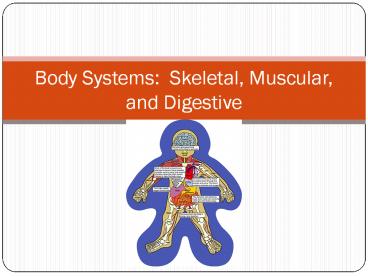Body Systems: Skeletal, Muscular, and Digestive - PowerPoint PPT Presentation
1 / 24
Title:
Body Systems: Skeletal, Muscular, and Digestive
Description:
Body Systems: Skeletal, Muscular, and Digestive Levels of Organization ~ Organ Systems Well how many systems do each of us have? Humans (mammals) Circulatory ... – PowerPoint PPT presentation
Number of Views:429
Avg rating:3.0/5.0
Title: Body Systems: Skeletal, Muscular, and Digestive
1
Body Systems Skeletal, Muscular, and Digestive
2
Levels of Organization Organ Systems
3
Well how many systems do each of us have?
- Humans (mammals)
- Circulatory
- Lymphatic
- Respiratory
- Reproductive
- Muscular
- Excretory
- Skeletal
- Endocrine
- Integumentary
- Nervous
- Digestive
4
Skeletal System
Introductory video clip Click Here!
5
Skeletal Functions (jobs)
- Gives shape and support
- Movement
- Protects internal organs
- Makes blood cells
- Stores calcium and other
- minerals.
6
Skeletal Structures (parts)
- Marrow- the inner part of the bone that makes red
blood cells, white blood cells, and platelets - Ligaments- tissue that connects one bone to
another bone - Cartilage- flexible connective tissue that is
found on the ends of bones to reduce friction
7
JointsWhere 2 bones meet
- Immoveable (fixed)- does not move (skull)
- Pivot- movement around a point (neck)
- Ball and Socket- allows 360 degree motion
(shoulder and hip) - Hinge- allows for open and close motion (knees
and elbows - Sliding- bones glide past one another (hands and
feet)
What did one bone say to the other bone?
Will you be jointing me tonight for dinner? LOL
8
Do all animals have a skeleton like ours?
Nope!
Scorpion
Sea Urchin
Not this guy! His skeleton is an exoskeleton (it
is on the outside of his body)
Not this one either. His skeleton is an
endoskeleton, but much different than ours.
Nope! At least he has a backbone like us.
Nautilus
Not him either! Although he has an endoskeleton,
it is still much different than ours.
Sting ray
9
Disorders of the skeletal system
Osteoporosis -- weakening of bone due to loss of
calcium. Usually in old age.
10
Muscular System
Introductory Video Click Here
11
Muscular--Functions
- Stability and Posture
- Motion
- Heat Production
- Circulation
- Digestion
12
Involuntary Muscles (not in our control)
Food digestion
13
3 Types of Muscles
Cardiac Muscle- muscle found in the heart
Involuntary
Skeletal Muscle- muscle attached to your bones
and helps you move
Voluntary
Smooth Muscle- lines organs such as blood
vessels, stomach and digestive tract.
Involuntary
Voluntary (control) or Involuntary (no control)??
14
How are our muscles attached to our bones?
Tendons attach our muscle to our bones.
15
The skeletal system and the muscular system work
together for movement
Try this out on your own arm. Bend it. Which
muscle is bulging or shortening? Which one is
lengthening? Straighten it. Now, which muscle is
bulging or shortening? And lenghthening?
16
Muscles help us do WORK.
- What is work and when is it really done?
Work is done when force is applied over a
distance.
In which picture is work being done?
Force Distance
Force Distance
17
Levers in the Human Body
18
Structures/Types of Muscle, contd.
Skeletal muscles that move your body around come
in two varieties flexors and extensors.
Flexors and extensors usually work in pairs, as
seen here
i. flexor bends a joint (biceps)
ii. extensor straightens a joint (triceps)
19
Disorders
Muscular dystrophy is a disease where a persons
muscles weaken after birth and the sick have
little control over them. Over time, people with
M.D. will often end up in wheelchairs as their
muscles fail them. Their minds are completely
healthy, though. No cure currently exists for
this disease. The MDA (Jerrys Kids) is the
most prominent charity searching for a cure.
20
Systems working together
- 1. Skeletal and Circulatory
- 2. Skeletal and Muscular
- Bone marrow makes red and white blood cells and
platelets.
- Muscles contract and relax to make the bones move.
21
Digestive System
Introductory Video Click Here
22
Digestive Functions (jobs)
- Physical breakdown of food
- Chemical breakdown of food
- Movement of food through the system
- Absorption of nutrients
- Elimination of waste
23
Digestive Structures (parts)
24
Disorders of the digestive system
- Appendicitis inflammation of the appendix
Doctors typically treat appendicitis with
antibiotics and surgery to remove the appendix.































